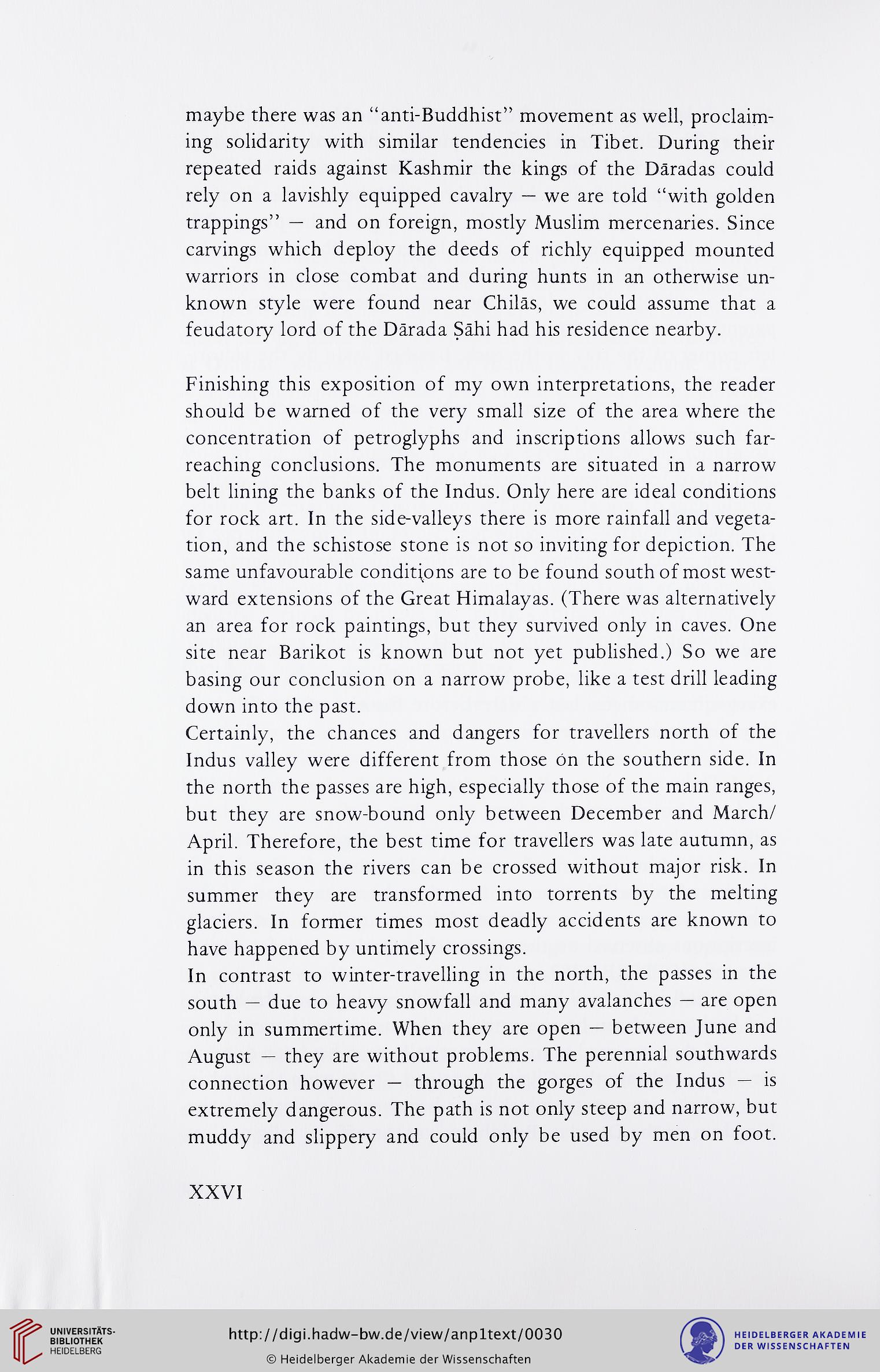maybe there was an "anti-Buddhist" movement as well, proclaim-
ing solidarity with similar tendencies in Tibet. During their
repeated raids against Kashmir the kings of the Daradas could
rely on a lavishly equipped cavalry — we are told "with golden
trappings" — and on foreign, mostly Muslim mercenaries. Since
carvings which deploy the deeds of richly equipped mounted
warriors in close combat and during hunts in an otherwise un-
known style were found near Chilas, we could assume that a
feudatory lord of the Darada Sahi had his residence nearby.
Finishing this exposition of my own interpretations, the reader
should be warned of the very small size of the area where the
concentration of petroglyphs and inscriptions allows such far-
reaching conclusions. The monuments are situated in a narrow
belt lining the banks of the Indus. Only here are ideal conditions
for rock art. In the side-valleys there is more rainfall and vegeta-
tion, and the schistose stone is not so inviting for depiction. The
same unfavourable conditions are to be found south of most west-
ward extensions of the Great Himalayas. (There was alternatively
an area for rock paintings, but they survived only in caves. One
site near Barikot is known but not yet published.) So we are
basing our conclusion on a narrow probe, like a test drill leading
down into the past.
Certainly, the chances and dangers for travellers north of the
Indus valley were different from those on the southern side. In
the north the passes are high, especially those of the main ranges,
but they are snow-bound only between December and March/
April. Therefore, the best time for travellers was late autumn, as
in this season the rivers can be crossed without major risk. In
summer they are transformed into torrents by the melting
glaciers. In former times most deadly accidents are known to
have happened by untimely crossings.
In contrast to winter-travelling in the north, the passes in the
south — due to heavy snowfall and many avalanches — are open
only in summertime. When they are open — between June and
August — they are without problems. The perennial southwards
connection however — through the gorges of the Indus — is
extremely dangerous. The path is not only steep and narrow, but
muddy and slippery and could only be used by men on foot.
XXVI
ing solidarity with similar tendencies in Tibet. During their
repeated raids against Kashmir the kings of the Daradas could
rely on a lavishly equipped cavalry — we are told "with golden
trappings" — and on foreign, mostly Muslim mercenaries. Since
carvings which deploy the deeds of richly equipped mounted
warriors in close combat and during hunts in an otherwise un-
known style were found near Chilas, we could assume that a
feudatory lord of the Darada Sahi had his residence nearby.
Finishing this exposition of my own interpretations, the reader
should be warned of the very small size of the area where the
concentration of petroglyphs and inscriptions allows such far-
reaching conclusions. The monuments are situated in a narrow
belt lining the banks of the Indus. Only here are ideal conditions
for rock art. In the side-valleys there is more rainfall and vegeta-
tion, and the schistose stone is not so inviting for depiction. The
same unfavourable conditions are to be found south of most west-
ward extensions of the Great Himalayas. (There was alternatively
an area for rock paintings, but they survived only in caves. One
site near Barikot is known but not yet published.) So we are
basing our conclusion on a narrow probe, like a test drill leading
down into the past.
Certainly, the chances and dangers for travellers north of the
Indus valley were different from those on the southern side. In
the north the passes are high, especially those of the main ranges,
but they are snow-bound only between December and March/
April. Therefore, the best time for travellers was late autumn, as
in this season the rivers can be crossed without major risk. In
summer they are transformed into torrents by the melting
glaciers. In former times most deadly accidents are known to
have happened by untimely crossings.
In contrast to winter-travelling in the north, the passes in the
south — due to heavy snowfall and many avalanches — are open
only in summertime. When they are open — between June and
August — they are without problems. The perennial southwards
connection however — through the gorges of the Indus — is
extremely dangerous. The path is not only steep and narrow, but
muddy and slippery and could only be used by men on foot.
XXVI




